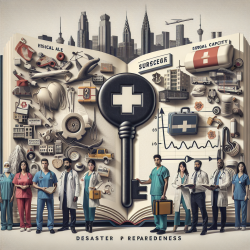Enhancing Critical Care During Disasters: A Practitioner’s Guide
In the face of disasters, the ability of healthcare systems to provide critical care is often stretched to its limits. The research article "Definitive Care for the Critically Ill During a Disaster: Medical Resources for Surge Capacity" offers a comprehensive framework for managing such situations. This blog will explore how practitioners can implement these findings to improve their skills and enhance outcomes for critically ill patients during disasters.
Understanding Emergency Mass Critical Care (EMCC)
The Task Force on Mass Critical Care has developed a set of guidelines to provide essential critical care during disasters, termed Emergency Mass Critical Care (EMCC). These guidelines focus on three main areas:
- Provision of medical equipment and consumables
- Expansion of treatment spaces
- Staffing models that utilize non-critical care personnel
By implementing these strategies, communities can better prepare to deliver augmented essential critical care in response to disasters.
Implementing Task Force Recommendations
Practitioners can enhance their skills by focusing on key recommendations from the Task Force:
- Ensure each EMCC patient has access to a mechanical ventilator that meets specific characteristics.
- Utilize hospital spaces efficiently by repurposing locations such as step-down units and large procedure suites for EMCC.
- Adopt a deliberate model of delegation to match staff competencies with patient needs, extending critical care capabilities.
These strategies are designed to maximize the delivery of essential critical care during disasters.
Encouraging Further Research and Preparation
While the Task Force provides a robust framework, it is crucial for practitioners to engage in further research and preparation. This involves:
- Conducting local needs assessments to determine the necessary quantities of medical resources.
- Participating in training programs that focus on disaster preparedness and EMCC implementation.
- Collaborating with regional healthcare systems to develop comprehensive disaster response plans.
By taking these proactive steps, practitioners can ensure they are well-prepared to provide critical care during disasters.
Conclusion
The research presented in "Definitive Care for the Critically Ill During a Disaster: Medical Resources for Surge Capacity" offers valuable insights for practitioners looking to improve their skills and outcomes during disasters. By implementing the Task Force's recommendations and engaging in further research, healthcare providers can enhance their ability to deliver critical care when it is needed most.
To read the original research paper, please follow this link: Definitive Care for the Critically Ill During a Disaster: Medical Resources for Surge Capacity.










